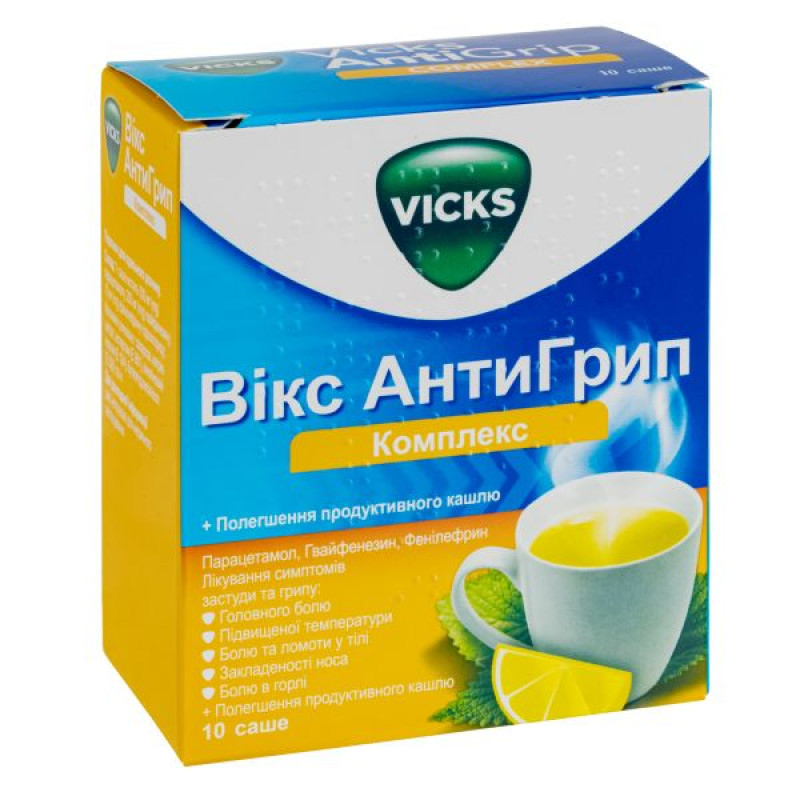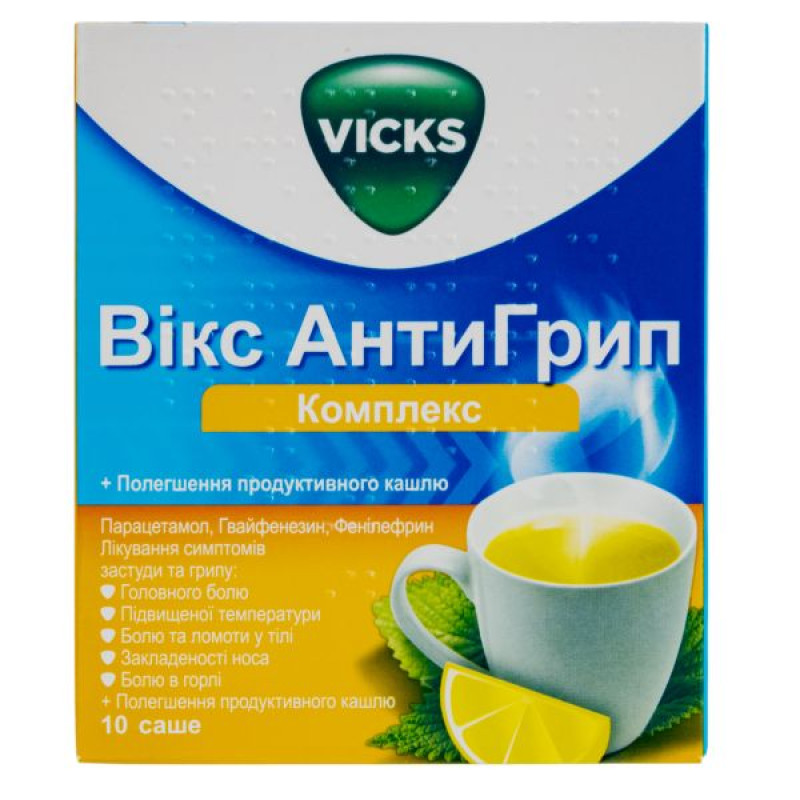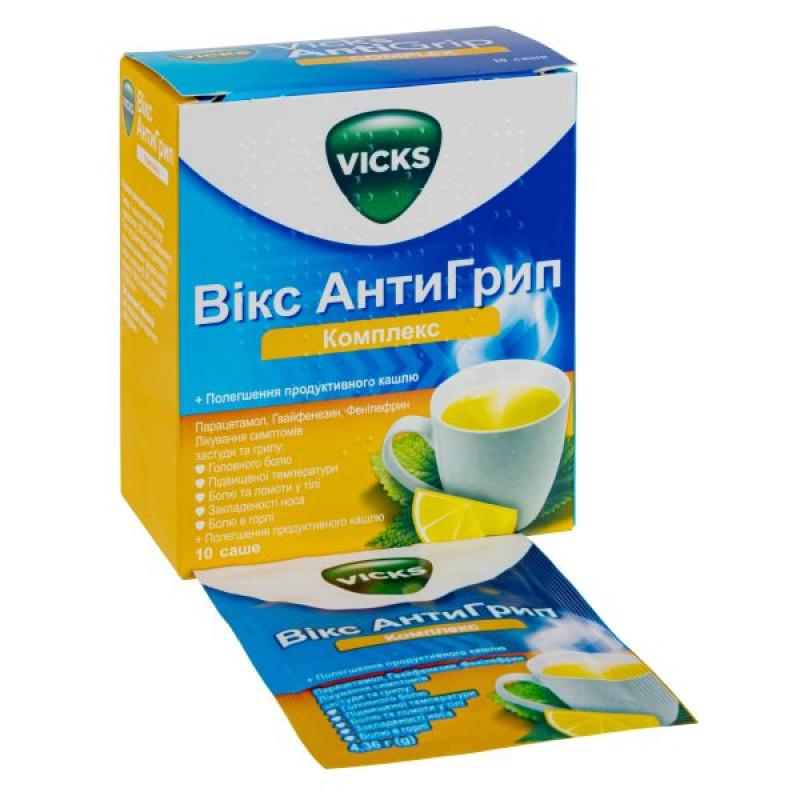Vicks Anti-Flu Complex powder for oral solution No. 10

Instructions for Vicks Anti-Flu Complex powder for oral solution No. 10
Composition
active ingredients: paracetamol, guaifenesin, phenylephrine hydrochloride;
1 sachet contains paracetamol 500 mg, guaifenesin 200 mg, phenylephrine hydrochloride 10 mg;
excipients: sucrose, anhydrous citric acid, tartaric acid, sodium cyclamate, sodium citrate, aspartame (E 951), acesulfame potassium, lemon flavor 8476 (contains butylhydroxyanisole (E 320)), lemon juice flavor, menthol flavor, quinoline yellow (E 104).
Dosage form
Powder for oral solution.
Main physical and chemical properties: almost white free-flowing powder, without large lumps or foreign particles. Has a characteristic citrus/menthol odor.
Pharmacotherapeutic group
Analgesics and antipyretics. Anilides. Paracetamol, combinations without psycholeptics. ATX code N02B E51.
Pharmacological properties
Pharmacodynamics.
Paracetamol has analgesic and antipyretic effects, which are believed to be mainly due to inhibition of prostaglandin synthesis in the central nervous system.
Guaifenesin is an expectorant. It works by increasing the volume and reducing the viscosity of secretions in the trachea and bronchi, which makes it easier to cough up phlegm.
Phenylephrine hydrochloride is a sympathomimetic that primarily stimulates α-adrenergic receptors. It is an anti-edematous agent and acts by vasoconstriction, reducing swelling, particularly of the nasal mucosa and paranasal sinuses.
The active ingredients do not cause a sedative effect.
Pharmacokinetics.
Paracetamol is rapidly and almost completely absorbed from the gastrointestinal tract, crosses the placental barrier, and a small amount is excreted in breast milk. 95% of acetaminophen is metabolized in the liver by sulfo- and glucuronide conjugation, as well as oxidation by the cytochrome P450 system. The half-life is from 1 to 3 hours. The duration of action is 3-4 hours. It is excreted by the kidneys, mainly in the form of metabolites, 3% of the substance is excreted unchanged.
Guaifenesin is rapidly absorbed from the gastrointestinal tract and metabolized to ß-(2 methoxy-phenoxy) lactic acid, an inactive metabolite that is excreted in the urine. The elimination half-life of guaifenesin is short, approximately 1 hour.
Phenylephrine hydrochloride is unevenly absorbed from the gastrointestinal tract and undergoes presystemic metabolism by monoamine oxidase in the intestine and liver. Thus, orally administered phenylephrine has reduced bioavailability.
It is excreted in the urine almost entirely as a sulfate conjugate. The plasma half-life is 2-3 hours.
Indication
Treatment of cold and flu symptoms (productive cough with difficult sputum discharge, headache, body aches and pains, sore throat, nasal congestion, and fever).
Contraindication
Hypersensitivity to paracetamol, guaifenesin, phenylephrine hydrochloride or any other component of the drug. Severe cardiovascular diseases, arterial hypertension, diabetes mellitus, angle-closure glaucoma, hyperthyroidism, urinary retention due to prostatic hyperplasia, pheochromocytoma.
Porphyria, liver dysfunction, acute hepatitis, pancreatitis, severe renal dysfunction. Alcoholism.
Concomitant use with monoamine oxidase inhibitors (MAOIs) (or use within two weeks of stopping such treatment), tricyclic antidepressants, paracetamol-containing drugs, β-blockers and other vasodilators or sympathomimetics.
Congenital hyperbilirubinemia (including Gilbert's syndrome), glucose-6-phosphate dehydrogenase deficiency, rare hereditary problems associated with fructose intolerance, glucose-galactose malabsorption or sucrase-isomaltase insufficiency, blood diseases, severe hemolytic anemia, leukopenia.
Phenylketonuria.
Children under 12 years old.
Interaction with other medicinal products and other types of interactions
Prolonged regular use of paracetamol may enhance the anticoagulant effect of warfarin and other coumarins with an increased risk of bleeding; infrequent use does not cause a similar effect.
Before using the drug, it is necessary to consult a doctor if the patient is using warfarin or similar drugs that have an anticoagulant effect.
The hepatotoxicity of paracetamol may be increased by excessive alcohol consumption.
Metoclopramide or domperidone may increase the rate of absorption of paracetamol, while cholestyramine may decrease it. Pharmacological interactions between paracetamol and other drugs have been reported. These interactions are unlikely to be clinically significant at recommended doses.
Anticonvulsants (including phenytoin, barbiturates, carbamazepine), which stimulate the activity of liver microsomal enzymes, may enhance the toxic effect of paracetamol on the liver due to an increase in the degree of conversion of paracetamol to hepatotoxic metabolites. With the simultaneous use of paracetamol with hepatotoxic agents, the toxic effect of drugs on the liver increases.
Concomitant use of high doses of paracetamol with isoniazid increases the risk of developing hepatotoxic syndrome.
Paracetamol reduces the effectiveness of diuretics.
Paracetamol may reduce the bioavailability of lamotrigine with a decrease in its effectiveness due to the induction of its metabolism in the liver.
Salicylates/acetylsalicylic acid may prolong the elimination of paracetamol from the body.
Concomitant therapy with paracetamol and NSAIDs (nonsteroidal anti-inflammatory drugs) increases the risk of renal dysfunction.
Probenecid inhibits the conjugation of paracetamol with glucuronic acid and thus reduces the clearance of paracetamol by almost half. When used simultaneously with probenecid, the dose of paracetamol should be reduced.
Concomitant use of paracetamol and AZT (zidovudine) increases the risk of neutropenia. Therefore, concomitant use of paracetamol and AZT should be carried out under medical supervision.
There is a hypertensive interaction between sympathomimetic amines such as phenylephrine and monoamine oxidase inhibitors. Phenylephrine may reduce the effectiveness of β-blockers and antihypertensive drugs. Phenylephrine increases the likelihood of arrhythmias in patients taking digitalis preparations. There is a possibility that digitalis preparations may sensitize the myocardium to the effects of sympathomimetic drugs. Conditions in which these drugs are used are a contraindication for this drug.
Phenylephrine may enhance the effects of other sympathomimetic amines (decongestants) on the cardiovascular system (in particular, the vasoconstrictor effect).
Concomitant use with halogenated anesthetics such as chloroform, cyclopropane, haloman, enflurane, or isoflurane may cause or worsen ventricular arrhythmias.
The drug may affect the results of laboratory tests for blood glucose and uric acid.
Guaifenesin enhances the effects of sedatives and muscle relaxants.
Phenylephrine hydrochloride should not be used with α-blockers, other antihypertensive agents, phenothiazine derivatives (e.g. promethazine), guanethidine, methyldopa, glucocorticosteroids, tricyclic antidepressants; appetite suppressants, amphetamine-like psychostimulants, ergot alkaloids; other central nervous system stimulants, theophylline. It should not be used with other vasoconstrictors (by any route of administration). Concomitant administration of phenylephrine and other sympathomimetics may lead to additional stimulation of the central nervous system to an extremely high level, accompanied by nervousness, irritability, insomnia. Convulsions are also possible.
Phenylephrine may cause hypertensive crisis or arrhythmia when used simultaneously with other adrenomimetics or MAO inhibitors, cause severe arterial hypertension when combined with indomethacin and bromocriptine. Simultaneous administration of phenylephrine with β-blockers may lead to arterial hypertension and excessive bradycardia with possible heart block. It should be used with caution with thyroid hormones, drugs that affect cardiac conduction (cardiac glycosides, antiarrhythmic drugs).
When used simultaneously with drugs that cause potassium excretion, for example, some diuretics such as furosemide, hypokalemia may be increased and arterial sensitivity to vasopressor drugs may be reduced.
A significant increase in blood pressure is possible with simultaneous intravenous administration of ergot alkaloids. The risk of developing ergotism increases with the combined use of phenylephrine and ergot alkaloids. Rauwolfia alkaloids reduce the therapeutic effect of phenylephrine. Atropine sulfate blocks the reflex bradycardia caused by phenylephrine and increases the vasopressor response to phenylephrine.
Caution should be exercised when using paracetamol with flucloxacillin, as concomitant administration has been associated with high anion gap metabolic acidosis, especially in patients with risk factors (see section "Special warnings and precautions for use").
Application features
Long-term use of the drug is not recommended.
If the headache becomes persistent, you should see a doctor.
Patients who take analgesics every day for mild arthritis should consult a doctor.
Due to the risk of overdose, do not use the drug simultaneously with other anti-cold, anti-edema and paracetamol-containing drugs. Before starting treatment, you should make sure that drugs containing sympathomimetics are not used simultaneously by several routes, i.e. orally and topically (drugs for the nose, ears and eyes).
Do not take with alcohol. The risk of hepatotoxicity is increased in patients with alcoholic liver disease and in patients who abuse alcohol.
It is necessary to consult a doctor regarding the possibility of using the drug in patients with persistent or chronic cough (caused by smoking, asthma, chronic bronchitis or emphysema).
The drug should be used with caution in the following cases: impaired renal function; myasthenia gravis; in combination with antitussives (contains guaifenesin). Since the drug contains paracetamol, it should be used with caution in patients taking hepatotoxic drugs, digitalis preparations, methyldopa or other antihypertensive drugs; in patients who are chronically malnourished (low glutathione levels), in patients with Raynaud's phenomenon, granulocytopenia, with severe hemolytic anemia, with acute gastrointestinal disorders.
Use with caution in patients with prostatic hypertrophy (due to the possibility of urinary retention).
Saccharose
This medicinal product contains sucrose. Patients with rare hereditary problems of fructose intolerance, glucose-galactose malabsorption or sucrase-isomaltase insufficiency should not take this medicinal product.
Sodium
This medicinal product contains 157 mg of sodium per dose. This should be taken into account by patients on a controlled sodium diet.
Aspartame
The medicine contains aspartame (E 951), a source of phenylalanine. May be harmful for people with phenylketonuria.
Caution is advised when paracetamol is co-administered with flucloxacillin due to the increased risk of high anion gap metabolic acidosis, particularly in patients with severe renal insufficiency, sepsis, malnutrition and other sources of glutathione deficiency (e.g. chronic alcoholism), and those taking maximum daily doses of paracetamol. Close monitoring, including measurement of urinary 5-oxoproline, is recommended.
Use during pregnancy or breastfeeding
The use of the drug is not recommended during pregnancy or breastfeeding due to insufficient data on the safety of its use.
The ability to influence the reaction speed when driving or working with other mechanisms
The drug has a slight effect on reaction speed, which should be taken into account when driving vehicles and working with other mechanisms.
Method of administration and doses
For internal use.
Dissolve the contents of 1 sachet in a standard cup (250 ml) of hot, but not boiling, water. Consume warm.
Adults, the elderly and children over 12 years of age: 1 sachet.
Repeat if necessary every 4–6 hours, but not more than four doses (4 sachets) per day; the interval between doses is at least 4 hours. Do not exceed the recommended doses, especially in patients with increased blood clotting.
The duration of treatment is determined by the doctor. Do not use the drug for more than 3 days without consulting a doctor. If the symptoms of the disease do not disappear, you should consult a doctor.
Children
Contraindicated in children under 12 years of age. Children over 12 years of age should use under the supervision of a physician.
Overdose
Paracetamol.
In case of overdose of the drug, the symptoms caused by paracetamol will be most pronounced. The risk of overdose is higher in elderly patients, children, patients with liver disease, chronic alcoholism, and chronic malnutrition.
If the patient has taken the drug in a dose that exceeds the recommended dose, a doctor should be consulted immediately due to the risk of liver damage, which can be fatal.
Liver damage is possible in adults who have taken 10 g or more of paracetamol, and in children who have taken more than 150 mg/kg of body weight. Liver damage can also occur after taking 5 g or more of paracetamol if the patient: is on long-term treatment with carbamazepine, phenobarbitone, phenytoin, primidone, rifampicin, St. John's wort or other drugs that induce liver enzymes; is a regular drinker or is suspected of having glutathione depletion, for example, in case of dietary disorders, cystic fibrosis, HIV infection, starvation, cachexia.
Symptoms.
With prolonged use of the drug in high doses, aplastic anemia, pancytopenia, agranulocytosis, neutropenia, leukopenia, thrombocytopenia may develop from the hematopoietic system. When taking high doses, from the central nervous system - dizziness, psychomotor agitation and disorientation; from the urinary system - nephrotoxicity (renal colic, interstitial nephritis, papillary necrosis).
Treatment.
In the treatment of paracetamol overdose, despite the absence of severe early symptoms, patients should be immediately hospitalized for emergency medical care. Symptoms may be limited to nausea or vomiting and may not reflect the severity of the overdose or the risk of organ damage.
Activated charcoal should be considered if paracetamol overdose has been taken within 1 hour. Plasma paracetamol levels should be measured 4 hours or later after ingestion (earlier levels are unreliable). Intravenous administration of SH-group donors and glutathione precursors (such as methionine, N-acetylcysteine) is recommended, in doses determined by the paracetamol blood concentration and the time elapsed since ingestion. N-acetylcysteine treatment can be used for up to 48 hours after ingestion of paracetamol, but the maximum protective effect is achieved when administered within 8 hours of ingestion. The efficacy of the antidote decreases sharply after this time. If necessary, the patient should be given intravenous N-acetylcysteine according to the established dose schedule. In the absence of vomiting, oral methionine can be used as a suitable alternative in remote areas outside the hospital.
Phenylephrine hydrochloride.
In case of overdose, the manifestations of adverse reactions may be increased, especially with prolonged use. Signs of severe phenylephrine overdose include: irritability, agitation, tremor, sleep disturbances, restlessness, anxiety, nervousness, headache, convulsions, palpitations, paresthesia, inappropriate behavior, psychosis with hallucinations, confusion, weakness, anorexia, nausea, vomiting, oliguria, urinary retention, painful or difficult urination, facial flushing, feeling of coldness in the extremities, hyperpyrexia, pain and discomfort in the heart, shortness of breath, non-cardiogenic pulmonary edema, increased blood pressure and associated reflex bradycardia and arrhythmia, pale skin, piloerection, increased sweating, hyperglycemia, hypokalemia, peripheral vasoconstriction, decreased blood flow to vital organs, which can lead to deterioration of renal blood supply, metabolic acidosis, increased workload on the heart due to increased total peripheral vascular resistance. Symptoms of severe overdose include severe peripheral and visceral vasoconstriction with cardiovascular collapse. Severe vasoconstriction is more likely in patients with hypovolemia and severe bradycardia.
Treatment includes early gastric lavage, as well as symptomatic and supportive measures.
Guaifenesin.
Overdose in small or moderate doses may cause dizziness, gastrointestinal upset. Very high doses may cause symptoms such as agitation, confusion, and respiratory depression.
Side effects
Immune system disorders: anaphylaxis; hypersensitivity reactions including angioedema.
Skin and subcutaneous tissue disorders: hypersensitivity reactions including skin rash, pruritus and urticaria, erythema multiforme. Very rare cases of severe skin reactions (including Stevens-Johnson syndrome), toxic epidermal necrolysis (Lyell's syndrome) have been reported.
From the side of the circulatory and lymphatic systems: anemia, sulfhemoglobinemia and methemoglobinemia (cyanosis, shortness of breath, heart pain), hemolytic anemia. With prolonged use in doses exceeding therapeutic doses, aplastic anemia, pancytopenia, thrombocytopenia, which can cause nosebleeds and/or bleeding gums, bruising or bleeding, leukopenia, neutropenia, agranulocytosis have been observed.
From the nervous system (usually developing when taking high doses): rarely dizziness, headache, psychomotor agitation, disorientation, impaired consciousness, insomnia, restlessness, nervousness, tremor, irritability, anxiety.
From the organs of vision: mydriasis, photophobia, acute angle-closure glaucoma.
From the cardiovascular system: tachycardia, bradycardia, heart pain, shortness of breath, increased blood pressure, palpitations, arrhythmia.
On the part of the digestive system: feeling of discomfort in the gastrointestinal tract, nausea, vomiting, diarrhea, loss of appetite, epigastric pain, acute pancreatitis.
From the urinary system: urinary retention or difficulty urinating (with prostate enlargement), renal colic, dysuria, aseptic pyuria. There are rare reports of bladder or kidney stones in patients who have taken large amounts of guaifenesin for a long time. Isolated cases of interstitial nephritis have been reported as a result of prolonged use of high doses of paracetamol.
On the part of the endocrine system: hypoglycemia, up to hypoglycemic coma.
Respiratory system: shortness of breath, bronchospasm in patients sensitive to acetylsalicylic acid and other NSAIDs.
Expiration date
3 years.
Storage conditions
Store out of the reach of children at a temperature not exceeding 25 °C.
Packaging
5 or 10 sachets in a box.
Vacation category
Without a prescription.
Producer
Rafton Laboratories Limited.
Location of the manufacturer and its business address
Exeter Road, Rafton, Braunton, EX3 2DL, United Kingdom.
There are no reviews for this product.
There are no reviews for this product, be the first to leave your review.
No questions about this product, be the first and ask your question.









